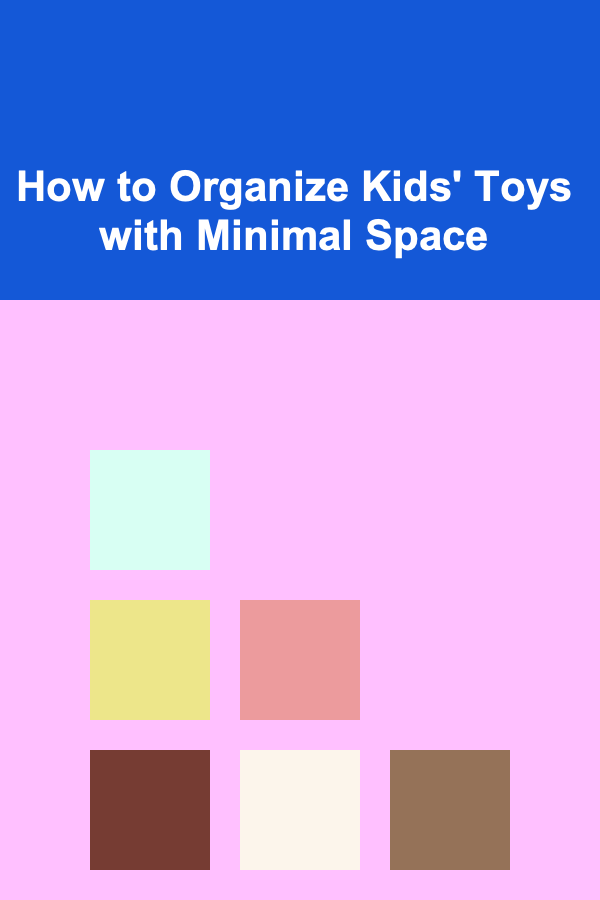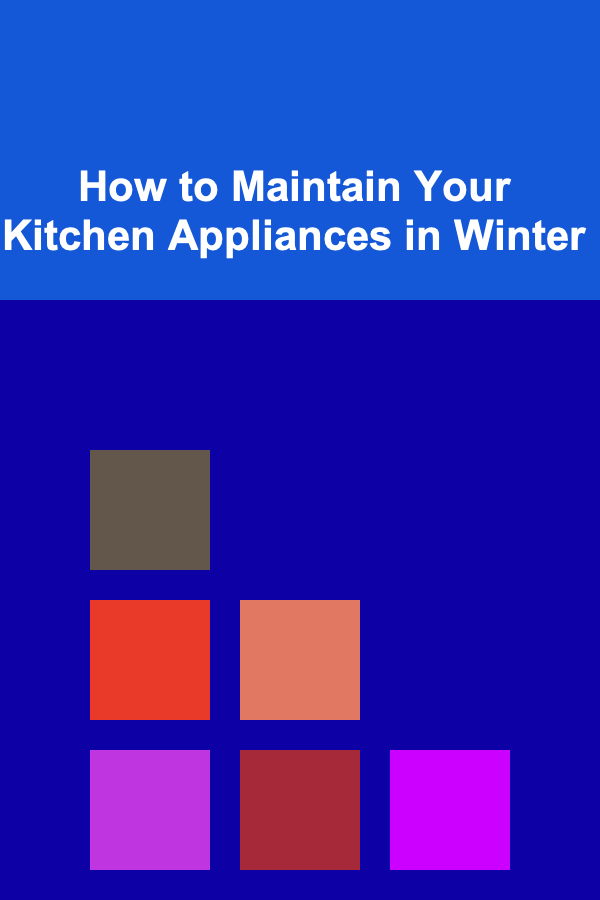
How to Organize Kids' Toys with Minimal Space
ebook include PDF & Audio bundle (Micro Guide)
$12.99$9.99
Limited Time Offer! Order within the next:

Organizing kids' toys can be a daunting task, especially in homes with limited space. The clutter that accumulates from toys can quickly take over living areas, making it difficult for both children and parents to find what they need. However, with some thoughtful strategies and creative solutions, you can effectively organize kids' toys even in the smallest of spaces. This comprehensive guide will explore various methods to declutter, organize, and maintain a toy-free zone, ensuring that your home remains both functional and enjoyable.
Understanding the Challenge of Toy Clutter
Before discussing organization strategies, it's important to recognize why toy clutter becomes overwhelming:
1. The Volume of Toys
Children often receive numerous toys as gifts or accumulate them over time, leading to an overwhelming collection. As they grow, interests change, and the volume of toys can fluctuate significantly.
2. Limited Storage Space
Many homes, especially those with multiple occupants, have limited storage options. This limitation can make it difficult to find a designated place for all the toys.
3. Kids' Engagement
Children may not understand the importance of tidiness or how to put their toys away properly. They often play with multiple items at once, leading to a chaotic environment.
4. Emotional Attachment
Kids can develop strong emotional ties to their toys, making it challenging for parents to encourage decluttering. This attachment can complicate the process of deciding which toys to keep and which to let go.
The Importance of Organization
An organized space contributes significantly to a child's ability to play, learn, and develop. Here are some key benefits of organizing kids' toys:
1. Promotes Independence
When toys are organized and easily accessible, children can independently choose what to play with and clean up afterward, fostering responsibility and self-sufficiency.
2. Reduces Stress
A tidy environment can reduce stress for parents and children alike. It creates a calming atmosphere where everyone can enjoy their space without feeling overwhelmed by clutter.
3. Enhances Playtime
When toys are well-organized, kids can quickly find what they want to play with. This ease of access encourages longer and more focused play sessions, enhancing creativity and engagement.
4. Fosters Learning
An organized play area allows for better learning opportunities. Children can explore different types of toys, engage in imaginative play, and learn to categorize and sort their belongings.
Strategies for Organizing Kids' Toys
With these challenges and benefits in mind, let's explore effective strategies for organizing kids' toys in minimal space:
1. Decluttering: The First Step
The first step to organizing toys is decluttering. This process involves sorting through the collection and deciding which items to keep, donate, or discard.
a. Set Clear Guidelines
Establish criteria for what to keep. Consider factors such as:
- Age appropriateness
- Condition of the toy
- Frequency of use
- Emotional significance
b. Involve Your Kids
Engaging your children in the decluttering process can help them understand the importance of organization. Ask them to identify their favorite toys and discuss any they no longer play with.
c. Create "Keep," "Donate," and "Trash" Piles
As you sort through the toys, create three distinct piles:
- Keep: Toys that meet your criteria and are still played with.
- Donate: Gently used toys that can be passed on to others.
- Trash: Broken or damaged toys that cannot be repaired.
d. Set Limits
Consider implementing a one-in, one-out policy. For every new toy that comes in, one must go out. This practice helps manage the overall volume of toys over time.
2. Choosing the Right Storage Solutions
Once you've decluttered, it's time to find suitable storage solutions. Here are some effective options for small spaces:
a. Bins and Baskets
Bins and baskets are versatile storage options that can be used in various ways:
- Types: Look for different sizes and materials, such as plastic, fabric, or wicker.
- Labeling: Label each bin to indicate its contents, helping kids know where to return items.
b. Shelving Units
Open shelving can maximize vertical space and provide easy access to toys:
- Wall-Mounted Shelves: Install shelves high enough that younger children cannot reach, storing less frequently used toys.
- Adjustable Shelves: Use adjustable shelving units that can grow with your child's changing interests.
c. Toy Chests
A toy chest or storage box can serve as a central location for toys:
- Multi-Functional: Choose a chest that doubles as seating or a decorative piece.
- Safety: Ensure it has a safety hinge to prevent pinched fingers.
d. Under-Bed Storage
Utilizing under-bed space is a clever way to store toys out of sight:
- Storage Bins: Use shallow bins that slide easily under the bed.
- Rolling Carts: Consider rolling carts that can be easily pulled out when needed.
3. Creative Organization Techniques
Beyond basic storage solutions, there are many creative techniques to keep toys organized:
a. Themed Play Areas
If space allows, create themed play areas based on different types of toys:
- Building Zone: Designate an area for blocks and construction toys.
- Reading Nook: Create a cozy corner filled with books and reading materials.
b. Vertical Storage Solutions
Maximize vertical space with innovative storage ideas:
- Hanging Organizers: Use hanging shoe organizers to store small toys, art supplies, or craft materials.
- Pegboards: Install a pegboard on the wall to hang toys, art supplies, or even sports equipment.
c. Clear Containers
Using clear containers can help kids see what's inside, making it easier for them to choose toys:
- Stackable Bins: Stackable bins save space and allow for visibility.
- Small Jars: Small jars can hold tiny toys or craft supplies, keeping them organized and visible.
4. Maintaining the Organized Space
Once you have successfully organized the toys, it's essential to maintain that organization:
a. Establish a Cleaning Routine
Encourage a daily or weekly cleaning routine where kids are responsible for putting away toys:
- Set a Timer: Make cleaning fun by setting a timer and seeing how many toys can be put away in a certain time frame.
- Incorporate Games: Turn cleaning into a game, such as racing against the clock.
b. Regularly Reassess the Collection
Periodically reassess the toy collection to ensure it remains manageable:
- Monthly Check-Ins: Spend a few minutes each month to evaluate what toys are being played with and what might need to be donated.
- Seasonal Decluttering: At the start of each season, revisit the toy collection to remove items no longer in use.
c. Educate About Care and Responsibility
Teach children about caring for their toys and the importance of organization:
- Model Behavior: Demonstrate how to put toys away, showing them the benefits of an organized space.
- Discuss Importance: Explain why it's important to keep their space tidy and how it can lead to more enjoyable playtime.
5. Additional Tips for Small Spaces
Here are some extra tips to help you organize kids' toys in minimal space:
a. Use Multi-Functional Furniture
Consider furniture pieces that serve multiple purposes:
- Ottomans with Storage: Ottomans can be used for seating while providing hidden storage for toys.
- Coffee Tables with Drawers: A coffee table with drawers can hold toys within easy reach.
b. Maximize Closet Space
Closets can be a great resource for toy storage:
- Shelving: Add shelves or bins within closets to separate toys by type.
- Door Hooks: Use hooks on the inside of closet doors for hanging storage options.
c. Utilize Hidden Storage
Look for hidden storage opportunities around the house:
- Couches with Storage: Some couches come with built-in storage compartments for toys.
- Furniture with Lift Tops: Tables or benches that lift to reveal storage can cleverly hide toys.
d. Rotate Toys
To keep playtime fresh and exciting, consider rotating toys:
- Storage Rotation: Store some toys away for a few weeks or months and then swap them out with others. This not only reduces clutter but also makes old toys feel new again.
Conclusion
Organizing kids' toys in a minimal space can be a manageable task with the right strategies and tools. By decluttering, choosing effective storage solutions, and maintaining the organized space, you can create an environment that promotes independence, reduces stress, and enhances playtime for your children.
It's important to remember that organization is not a one-time effort but an ongoing process. By involving your children, establishing routines, and revisiting the toy collection regularly, you can foster a positive relationship with organization and help your kids develop lifelong skills in managing their belongings.
Ultimately, a well-organized space can transform your home into a more enjoyable and functional place, allowing you and your family to focus on what truly matters---spending quality time together. Embrace these strategies, and take control of the toy clutter for a happier, more organized home life.
Reading More From Our Other Websites
- [Organization Tip 101] How to Use a Recipe Box for Traditional Storage Methods
- [Beachcombing Tip 101] How to Clean and Restore Antique Sea‑Glass Jewelry Found While Beachcombing
- [Trail Running Tip 101] Top 10 Must‑Run Trail Adventures to Add to Your Bucket List
- [Paragliding Tip 101] Best Paragliding Community Forums for Sharing Flight Logs and Route Advice
- [Home Storage Solution 101] How to Utilize Hidden Storage Spaces in Your Home
- [Polymer Clay Modeling Tip 101] Color Blending Magic: How to Create Stunning Gradients in Polymer Clay
- [Organization Tip 101] How to Create a Travel Guidebook for Future Trips
- [Home Family Activity 101] How to Collect and Craft Amazing Family Campfire Stories That Become Cherished Traditions
- [Organization Tip 101] How to Plan a Family Reunion Photo Album
- [Organization Tip 101] How to Use Technology for Effective Goal Setting

How to Create a Boho Chic Look in Your Home on a Budget
Read More
How to Create a Proactive Customer Service Checklist
Read More
How to Maintain Your Kitchen Appliances in Winter
Read More
How to Make DIY Home Spa Activities for Family Relaxation
Read More
How To Build Strategic Partnerships
Read More
Experiencing the Safari in South Africa: A Comprehensive Guide
Read MoreOther Products

How to Create a Boho Chic Look in Your Home on a Budget
Read More
How to Create a Proactive Customer Service Checklist
Read More
How to Maintain Your Kitchen Appliances in Winter
Read More
How to Make DIY Home Spa Activities for Family Relaxation
Read More
How To Build Strategic Partnerships
Read More